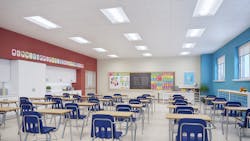School districts are saddled with several competing challenges. On the one hand, they are expected to maintain an engaging learning environment and support student and staff comfort. On the other hand, they face a tight budget with limited resources. As if balancing these conflicting demands wasn’t enough, school infrastructure upgrades have long been overlooked in favor of more pressing priorities.
The average U.S. public school is more than 50 years old. Districts cannot wait any longer to begin modernizing their facilities. One place to begin those upgrades is lighting.
Lighting the path forward
The aging infrastructure of the typical school facility means that most are still using conventional light sources with a traditional on/off switch. But modern technology enables education facilities to integrate smart sensors into their lighting systems and connect them to cloud-based software. This will unlock greater control and value for a district beyond that basic illumination.
By leveraging the Internet of Things (IoT), schools can enrich their learning environments and support their bottom line.
Here are three beneficial lessons a district can from upgrading its lighting system:
Lesson 1: Cultivating a comfortable learning environment is paramount to a school’s success.
Ask educational professionals what’s most important at their school, and the answer would be unanimous: the students. The lighting in a classroom is a simple yet effective way to help stimulate students’ learning.
For example, teachers can use connected lighting to tailor light scenes or settings in their individual classrooms through a scene switch on the wall. A study done at the University Hospital in Hamburg-Eppendorf on school children in classroom environments found that dynamic lighting like this can increase their reading speed by 35% and decrease their frequency of errors by 45%.
The lighting can even be synced with the time of day to support students’ and teachers’ natural day-night or circadian rhythms, which dictate our biological clocks and energy levels. Teachers can set a scene with a crisp, bright tone of white light to inspire concentration and focus for a lesson or presentation. Then, they can scale down the lighting to warmer tones during quiet times or breaks so that students can relax and recharge.
Lesson 2: Freeing up operational costs can have a significant impact on your bottom line.
Each year, K-12 schools collectively spend around $8 billion on energy. Lighting accounts for around 9% of that expenditure. But unlike a conventional light source, which expends more energy to achieve the same light output, a connected LED lighting system can increase energy savings by up to 90% and help reduce operational costs.
A noteworthy example of this is in school hallways, where the lights are often left on at full power all day. With a connected lighting system, facility managers could create zones in their buildings and adjust the lighting accordingly. They could power off every few lights or dim them to save energy while the space is unoccupied, but still leaving some illumination for security.
If a student or faculty member enters a darkened hallway, occupancy-sensing technology instantly activates the right light levels. This is especially useful in larger areas, like cafeterias, libraries and gymnasiums, or other spots where foot traffic may be inconsistent, like bathrooms or recreational spaces.
To pick up additional energy savings, the lights can even be scheduled in accordance with classes ending – or automatically dimmed to compensate for extra daylight seeping in through windows. Together, these functions enable schools to use energy only when and where it is needed – maximizing operational efficiency, so limited funds can be spent on other areas like curriculum or supplies.
Lesson 3: Using data-based insights is key to improving your facilities for students and staff.
Students, teachers and administrators can all benefit from better facilities management, but accomplishing that goal may be complicated. It entails much more than just fixing broken equipment.
With a connected lighting system, facility managers can get a richer picture of their school buildings to help them make more informed decisions about day-to-day operations. For example, in a dashboard, administrators can track energy usage across an entire district, building or even an individual room for more granular insights. This information can be used to help a district gain access to certain utility-driven rebate programs that may provide additional funds to reinvest back into classrooms and students.
Additionally, from these reports, facility managers will be able to identify how often each room is used and where reduction opportunities lie. For instance, historical data can be leveraged to streamline heating and cooling functions; districts will no longer be allocated their limited dollars to heating or cooling unoccupied spaces.
A Brighter Future
Schools are now preparing their buildings for the coming year, and lighting is one area where improvements may be overdue. Connected lighting provides a platform for a district to transform its schools into smarter learning environments.Rahul Shira is a Senior Product Marketing Manager at Signify, a provider of lighting systems.About the Author
Rahul Shira
Rahul Shira is a Senior Product Marketing Manager at Signify.
